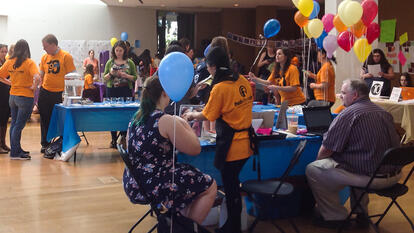Ceallach Gibbons ’17 Swims the English Channel to Help Raise Awareness of Sexual Violence

This summer, Ceallach Gibbons ’17 undertook the monumental challenge of swimming the 21-mile English Channel to help raise awareness of sexual violence and raise funds for the Boston Area Rape Crisis Center. In doing so, she joined an elite group of just over 1,600 swimmers, of whom 36 percent are women, who have crossed one of the busiest shipping lanes in the world.
“One in four women will survive a sexual assault by the time they graduate college,” said Gibbons, a political science and history double major who began advocating for victims of assault when she was in high school. “Perpetrators count on their victims to remain silent, and the statistics suggest that silence is by far the norm. That needs to change.”
Gibbons, who started swimming at age 6 and has competed nationally as a member of the STAR Swim Team in her home state of Minnesota, was inspired to swim the English Channel after hearing about the experience of her friend Gabriela “Ika” Kovacikova ’14, who successfully crossed in 2013. Gibbons began training for the journey last May in waters near Boston—the L Street Beach in Southie, Nahant Beach, and Crane Beach—and she hired a boat pilot to be her main contact for crossing advice and to escort her across the Channel.
The Channel swim season runs from July to September, according to the Channel Swimming Association, when the winds are mild and the water warm enough for swimmers. In mid-July, Gibbons flew to England. She began her quest at 11:40 pm on July 21, with her parents, her two siblings, and her pilot in the boat alongside her.
At first everything went well. “The water was unseasonably warm, it was 60 to 62 degrees for the entire swim,” Gibbons said. “While that is about 20 degrees colder than the average competition pool, and about 30 degrees colder than a comfortable recreational pool, I had spent all spring and summer training consistently in 55 degree water. The jellyfish were annoying, but I had sustained worse stings before, so they didn’t bother me.”
Gibbons was on pace for about an 11-hour swim, she said—the average solo crossing time is 13 hours and 30 minutes—but around hour nine, she began to feel extreme pain in her right shoulder. “Given that I had made some great progress, I could pretty clearly see the French coastline, so that was incredibly motivating,” she said. “More importantly, though, I was motivated by all the survivors of sexual violence who were following that swim back at home via a GPS tracker. I felt the strength of over 50 women during that swim, and I didn’t even consider the possibility of not finishing.”
For the next six hours, Gibbons relied heavily on her left arm, not realizing that she had torn her right labrum (shoulder cartilage). “I don’t think it would have been physically possible for me to continue without the additional motivation,” she said.
After swimming 15 hours and 26 minutes, she finally reached the French shore. “At the time I felt exhausted! But now that I’m a little more removed from the swim, I feel more capable and in a better position to help other women than I did before it,” said Gibbons, who hopes to swim the Catalina Channel and swim around Manhattan Island to raise funds for survivors of sexual violence.
“One of the most important takeaways from my experience at Wellesley is that women belong in power,” said Gibbons, who plans to become a lawyer specializing in reproductive justice. “When women are in charge, things get done. It is incredibly empowering to be at a school where everything is run by women. That constant exposure to female leadership instilled in me a sense of belonging and supreme confidence when I’m outside the classroom.”



